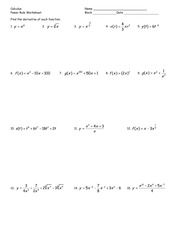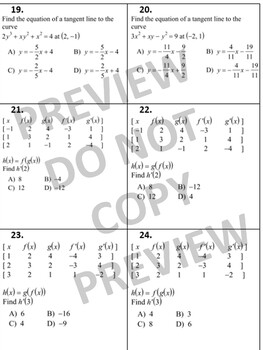

So you really want to have a handle of what you can take the derivative of here. Witht he chain rule thoughyou only really need to concern yourself with breaking the function up into different "types".so x^(3e) could be broken up into x^3 and x^e, but you can take the derivative of x^(3e) on its own, so you do not need to count it as composite. Now, as kubleeka says any function can be written as another composite, you could also write cos^(3e)(x) as the composite of two functions, cos(x) and x^(3e), so there are infinitely many combinations.
#Calculus chain rule worksheet with answers how to#
(cos(x))^(3e) = cos^(3e)(x) I hope that helps you catch how to discern composite functions. Now we replace x with the next one, which is g(x) so (g(x))^3 = (x^e)^3 = x^(3e) now replace x with the next one, which is cos(x) Now, you want to replace x with whatever g(x) is so (g(x))^2 = (sin(x))^2 = sin^2(x)į(g(h(x))) has the outtermost function f(x) so we start with x^3 f(g(x)) = sin^2(x) while g(f(x)) = sin(x^2).Ī way you can think of it is you start with the outtermost function so f(g(x)), the outter function is x^2. If both things happen then it is a composite function of the two. so x^2 could be one function then sin(x) could be another. Given the following information use the Chain Rule to determine zt z t and zp z p. Chain Rule Worksheet chain rule worksheet math 1500 find the derivative of each of the following functions using the chain rule. And there are other functions that can be written both as products and as compositions, like d/dx cos(x)cos(x).Īn extension of what Kubleeka answered, you want to start with JUST the variable and then see how many things are done to it.

There are other functions that can be written only as products, like d/dx sin(x)cos(x). In summary, there are some functions that can be written only as compositions, like d/dx ln(cos(x)).

recognizes that we can rewrite as a composition d/dx cos^2(x) and apply the chain rule. You can see this by plugging the following two lines into Wolfram Alpha (one at a time) and clicking "step-by-step-solution":įor d/dx sin(x)cos(x), W.A. This suggests that the problem we are about to work (Problem 2) will teach us the difference between compositions and products, but, surprisingly, cos^2(x) is both a composition _and_ a product. Immediately before the problem, we read, "students often confuse compositions. The placement of the problem on the page is a little misleading. Yes, applying the chain rule and applying the product rule are both valid ways to take a derivative in Problem 2. For example, cos ( x 2 ) \greenD f ′ ( g ′ ( x ) ) start color #11accd, f, prime, left parenthesis, end color #11accd, start color #ca337c, g, prime, left parenthesis, x, right parenthesis, end color #ca337c, start color #11accd, right parenthesis, end color #11accd.


 0 kommentar(er)
0 kommentar(er)
